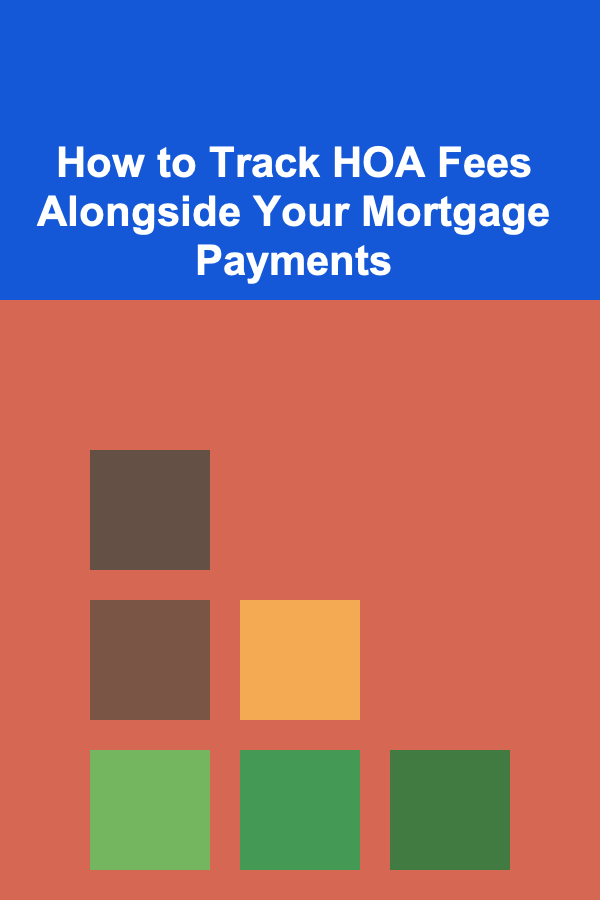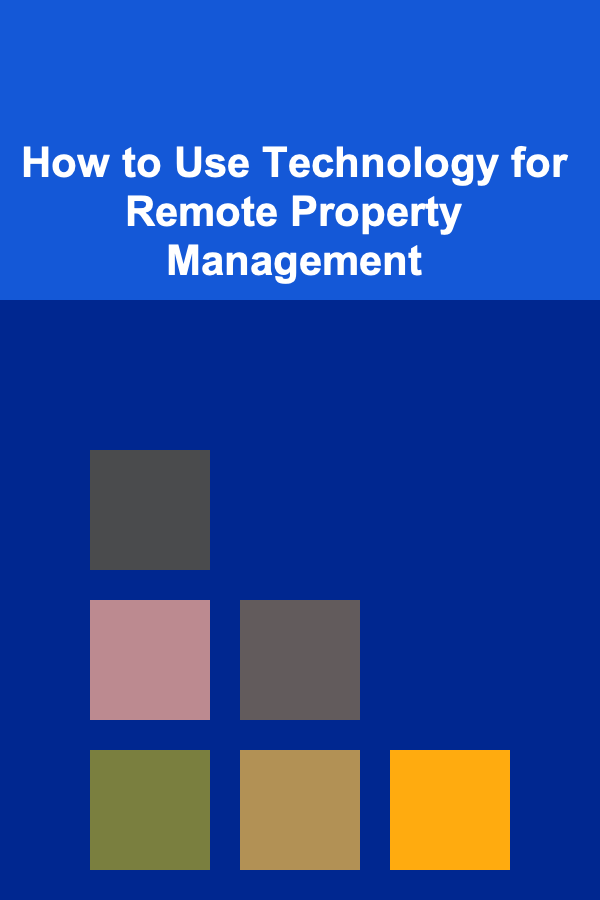
How to Track HOA Fees Alongside Your Mortgage Payments
ebook include PDF & Audio bundle (Micro Guide)
$12.99$10.99
Limited Time Offer! Order within the next:

When you become a homeowner, you quickly realize that your financial responsibilities go beyond just paying your monthly mortgage. Homeowners' Association (HOA) fees are another recurring expense that many homeowners face, particularly in communities that are governed by an HOA. Tracking HOA fees alongside mortgage payments is essential for managing your finances effectively and ensuring that you don't miss payments that could lead to penalties or even legal issues.
In this article, we will explore various methods and tools to help you track HOA fees alongside your mortgage payments. From understanding what HOA fees are and how they work, to the best strategies for budgeting and automating payments, this guide will equip you with everything you need to stay on top of both your mortgage and HOA fees.
What Are HOA Fees?
HOA fees are regular charges levied by a homeowners' association to fund the maintenance and operation of common areas and amenities within a community. These fees vary significantly depending on the location, size of the community, and the amenities provided. Common services funded by HOA fees include:
- Maintenance of common areas: This includes landscaping, snow removal, and upkeep of shared spaces like parks, clubhouses, and pools.
- Insurance for shared properties: The HOA typically carries insurance that covers the common areas, which can reduce individual homeowner insurance costs.
- Security services: Some HOAs provide 24-hour security, gates, or other safety measures.
- Community amenities: These might include gyms, playgrounds, or event spaces that are for the exclusive use of the community members.
HOA fees are typically collected on a monthly, quarterly, or annual basis and can range from a few dollars to several hundred per month, depending on the size and amenities of the community.
Why Tracking HOA Fees Is Important
Many homeowners struggle to track HOA fees alongside their mortgage payments, often overlooking the importance of this task. Tracking HOA fees is crucial for several reasons:
- Budgeting: Like mortgage payments, HOA fees are a recurring cost. Failing to include them in your budget can lead to unexpected financial shortfalls.
- Preventing Late Fees: Just like your mortgage payment, missing an HOA fee payment can result in late fees or penalties. Some HOA communities may even take legal action for non-payment.
- Accountability: If you're paying HOA fees separately from your mortgage, you need a system that ensures you're meeting all your financial obligations.
- Tax Implications: In some cases, HOA fees can be tax-deductible if they are directly tied to the maintenance of the property. Tracking them accurately can help when filing your taxes.
- Clarity and Peace of Mind: Keeping track of both your mortgage and HOA payments provides clarity about your total housing expenses, which can help avoid financial stress and ensure you are always prepared.
Methods for Tracking HOA Fees
1. Using a Spreadsheet for Tracking
One of the simplest and most customizable ways to track your HOA fees alongside your mortgage payments is by using a spreadsheet. Spreadsheets offer flexibility in design, and you can tailor them to your specific needs. Whether you're using Microsoft Excel, Google Sheets, or another spreadsheet software, here are some tips for creating an effective tracking sheet:
- Create Separate Columns for Each Expense: Set up columns for your mortgage payment, HOA fees, and any other recurring home expenses such as utilities, taxes, and insurance. This will allow you to easily see where your money is going each month.
- Add a Date Column: Record the due dates for both your mortgage and HOA fees. This will help you track when each payment is due and avoid late fees.
- Use Formulas for Calculations: You can set up formulas to automatically calculate the sum of your mortgage payment and HOA fee each month, and even track any increases or changes over time.
- Set Reminders: Many spreadsheet applications allow you to set reminders for upcoming payments. This is an especially useful tool for keeping track of HOA fee due dates.
Example Spreadsheet Layout:
| Date | Mortgage Payment | HOA Fee | Total Payment | Status (Paid/Unpaid) | |------------|----------------------|-------------|-------------------|--------------------------| | 01/01/2025 | $1,200 | $150 | $1,350 | Paid | | 02/01/2025 | $1,200 | $150 | $1,350 | Paid | | 03/01/2025 | $1,200 | $150 | $1,350 | Unpaid |
2. Automating Payments and Notifications
Another effective method for tracking both mortgage payments and HOA fees is to automate the payments through your bank or through each service provider's online platform. Automation reduces the risk of missing a payment and allows you to keep better track of your finances.
- Mortgage: Most mortgage lenders offer automatic payment options where you can set up recurring payments directly from your bank account. Ensure that your account has enough balance to cover both the mortgage and HOA fees.
- HOA Fees: Many HOAs offer automatic payment options as well. If your HOA does not, you can schedule regular bill payments through your bank's online bill pay feature.
- Reminders and Notifications: If you don't want to automate the payments but still want to stay on top of them, set up calendar reminders on your phone or computer for the due dates of both your mortgage and HOA fees. Many banks and HOA management companies also send email reminders or texts before the payment is due.
3. Using Personal Finance Apps
Several personal finance apps allow you to track both your mortgage payments and HOA fees along with other bills and expenses. Apps like Mint, YNAB (You Need A Budget), and PocketGuard can be particularly helpful for managing your entire financial picture. Here's how you can use them:
- Mint: This free app syncs with your bank account and credit cards, allowing you to automatically import mortgage and HOA payments. You can also set up custom categories to track your HOA fees as a separate expense.
- YNAB (You Need a Budget): YNAB is a great app for people who want to allocate their money intentionally. You can create specific categories for both your mortgage and HOA fees and track your progress each month.
- PocketGuard: This app gives you a quick overview of your spending, showing you how much money you have left after accounting for bills like your mortgage and HOA fees.
By linking your bank accounts to these apps, you can get real-time updates on your payments and have a clear view of your financial situation. These apps can also send you alerts when your payment dates are approaching.
4. Utilizing Banking Tools and Bill Pay Services
Many banks offer tools designed specifically for tracking and paying bills, including mortgage and HOA fees. Here's how you can use banking tools to track these payments:
- Online Banking Bill Pay: Most banks allow you to set up bill payments directly through their website or mobile app. You can set up recurring payments for both your mortgage and HOA fees and track their status within your account.
- Account Categorization: Some banks automatically categorize transactions into different spending groups (e.g., mortgage, utilities, entertainment, etc.), allowing you to see how much you are spending on your mortgage and HOA fees over time.
- Payment Tracking: If you use online banking, you can easily check the status of both payments, including whether they were processed on time or if there were any issues.
Strategies for Budgeting HOA Fees Alongside Mortgage Payments
While tracking your HOA fees is essential, it's equally important to budget for these expenses effectively. Here are some strategies to help you stay financially prepared:
1. Include HOA Fees in Your Monthly Budget
When creating a budget, make sure to include your HOA fees as a fixed monthly expense. If your HOA charges quarterly or annually, break the fee into monthly increments so that you can set aside the appropriate amount each month.
For example, if your HOA fee is $600 per quarter, allocate $200 each month into your budget to ensure you have enough funds to cover it when it's due.
2. Create an Emergency Fund for Unexpected Fees
In some cases, HOA fees can increase over time, or unexpected special assessments might arise (e.g., for large maintenance projects like roof repairs or landscape improvements). To avoid financial strain when these changes occur, consider setting aside an emergency fund specifically for HOA fees. Having a buffer can help you cover these increases without disrupting your budget.
3. Monitor for Changes in Fees
HOA fees may fluctuate based on the needs of the community or the board's decisions. Regularly check for notifications from your HOA about fee increases or other changes. Understanding these potential changes ahead of time will help you plan your budget accordingly.
Conclusion
Tracking HOA fees alongside your mortgage payments is an essential step for homeowners to ensure financial stability and avoid penalties. Whether you choose to track these payments through a spreadsheet, automate them, use personal finance apps, or rely on your bank's tools, the key is consistency. By keeping track of both your mortgage and HOA fees, you can better manage your finances, avoid late payments, and be prepared for any future changes in your housing costs.
By following the methods outlined in this article, you'll be able to create a solid system for tracking and managing your housing expenses with ease. This proactive approach will help you stay on top of your financial obligations and ensure that you maintain a healthy financial standing.
Reading More From Our Other Websites
- [Organization Tip 101] How to Host a Successful Fundraising Event
- [Biking 101] How to Maintain Your Bike Accessories for Long-Lasting Use
- [Home Budget Decorating 101] How to Add Texture to Your Home on a Budget
- [Home Pet Care 101] How to Brush a Long-Haired Dog: A Step-by-Step Guide for Preventing Mats and Tangles
- [Home Storage Solution 101] How to Install Wall-Mounted Storage for a Clutter-Free Kitchen
- [Home Family Activity 101] How to Plan a Family DIY Movie Theater Experience at Home
- [Home Family Activity 101] How to Plan the Ultimate Family Game Night with Fun Ideas
- [Organization Tip 101] How to Keep Track of Sales and Inventory During Your Yard Sale
- [Personal Investment 101] Top 5 Ways to Make Money Using Deep Learning
- [Home Space Saving 101] How to Organize a Clutter-Free Entryway in Small Homes

How to Create a Pet Care Plan for Emergencies
Read More
How to Leverage Robo-Advisors for Automated Investment Growth
Read More
How to Use Technology for Remote Property Management
Read More
How To Shoot B-Roll Footage Effectively
Read More
How to Transition to a Digital Insect Care Checklist
Read More
How to Track Weekly Spending for Travel Savings
Read MoreOther Products

How to Create a Pet Care Plan for Emergencies
Read More
How to Leverage Robo-Advisors for Automated Investment Growth
Read More
How to Use Technology for Remote Property Management
Read More
How To Shoot B-Roll Footage Effectively
Read More
How to Transition to a Digital Insect Care Checklist
Read More